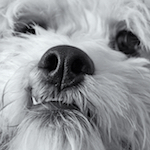|
So a shot of my cat with my 35mm at f1.8 would have less bokeh than the same shot at f1.8 with my 50mm but me standing farther back (aka same framing)
|
|
|
|

|
| # ? May 9, 2024 08:10 |
|
FISHMANPET posted:So a shot of my cat with my 35mm at f1.8 would have less bokeh than the same shot at f1.8 with my 50mm but me standing farther back (aka same framing) Sounds like you own both lenses, go do some science for us. You'd see more difference with a longer focal length than 50mm though.
|
|
|
|
Short focus distance + large diaphragm opening = low depth of field. In this, the diaphragm opening is measured absolutely, rather than the usual f-stop ratio. Example: A 100mm lens at f/2.0 has a 50mm diaphragm opening, while a 50mm lens at f/2.0 has a 25mm diaphragm opening, so the 100mm has lower depth of field. However if you set the 100mm at f/4 instead, but kept the 50mm at f/2, they would both have a 25mm opening, and so should produce the same depth of field at a given focusing distance. The quality of bokeh depends on the optical construction of the lens and the shape of the diaphragm. In fact, the shape is directly transferred, which is why Lensbaby offers oddly shaped aperture inserts and even cut-your-own ones.
|
|
|
|
|
I didn't realize that the f number was related to the focal length of the lens, I just knew lower f number = MORE BOKEH. So that explains why longer lenses have bigger f numbers, because you'd need an enormously wise lens for an f1.4 at 500mm.
|
|
|
|
nielsm posted:In fact, the shape is directly transferred, which is why Lensbaby offers oddly shaped aperture inserts and even cut-your-own ones. Seriously though, who would make a custom bokey filter for the front of their lens that's just crazy ta- 
|
|
|
|
I keep trying to find a simple way of explaining this, but I'll try.... While keeping your subject the same size in the frame, the longer focal length "magnifies" the background. The result is out of focus areas appear even more out of focus as there are less background elements in your shot, even though technically the background elements are not "more" out of focus at the same aperture.
|
|
|
|
I assume you mean same subject size in the frame, not same framing. It would be impossible to get the same framing with two different lenses. The short answer is that longer lenses, wider aperture and bigger sensors give "better" bokeh. But if you say it that simply on a forum somewhere there is a good chance you will be crucified because bokeh is a lot more complicated than that. For starters, the term "bokeh" actually refers to the quality of the out of focus area not just that there is one. The quality of the out of focus area can depend a lot on the construction of the lens. You've probably seen the way far away points of light that are out of focus are transformed into big, surreal circles. The shape that those points of light take actually depends upon the image circle which is typically created by the lens diaphram. A different lens construction can yield very different bokeh. For instance, a mirror telephoto lens creates donut bokeh like in this picture:  You can alter the image circle on your lens by putting a cutout in front of your lens and focusing past it. This is how people create music note shaped bokeh, or heart shaped bokeh. I played with it once, here is the cutout on the lens and the picture I made:   Lenses regarded for their really nice bokeh have more aperture blades resulting in a more perfect circle being created by the lens diaphram. The result is smoother, creamier bokeh. There are probably other important characteristics as well, I'm not well versed on the particulars of what gives a lens "great" bokeh. When thinking about bokeh it's important to realize how wide apertures, bigger sensors and longer lenses contribute to the bokeh in a shot. The simplest effect to wrap your head around is the effect of a wider aperture. As you open up your aperture the depth of field decreases, increasing the amount of background blurriness. Focal length is a bit trickier. To really understand its effect we need to also talk about subject distance. Lets say you have a 35mm lens @ É/2 and your subject is a person 10 ft away from you. Now say you want to take a shot of that same person with a 200mm lens @ É/2 but have them be the same size in the frame. To do so you would need to be ~57 ft away from them. If that makes sense to you now consider what happens to depth of field. Using the calculator here we can see that if we were using a D4 the DOF at 10 ft, 35mm É/2 would be 3.02ft. The DOF at ~57ft, 200mm É/2 would be 2.95 ft. If not for the loss of precision in the subject distance the DOF would be the same. But you probably intuitively know (and unfortunately I don't have sample images to show off this effect) that you'd hardly see any bokeh on the 35mm shot whereas you'd probably see some nice, dramatic bokeh on the 200mm shot. So what is the deal? If the DOF is the same then why would there be great bokeh on the 200mm shot but not on the 35mm shot? The answer is that the telephoto magnifies things that are in the background. This includes things like distant out of focus points of light. They're tiny in the 35mm shot but actually quite large and noticeable in the 200mm shot. Here is some insane 200mm É/2 full frame bokeh   Sensor size plays a role in the apparent depth of field as well. If we keep subject distance and aperture constant but vary the focal length to achieve the same field of view, we see that a larger sensor has a smaller depth of field than a smaller sensor. E.g. Take a 50mm É/2 lens @ 10 ft subject distance on a full frame body. DOF is 1.45 ft. Take the equivalent 33mm É/2 @ 10 ft on a crop factor body (using nikon crop factor of 1.5). DOF is 1.99 ft. So the full frame guys have a big advantage when it comes to sweet sweet bokeh. But small sensors aren't all bad. Using a teeny tiny sensor can be dead useful for video since there is so much DOF that stuff never goes out of focus. Hence why point and shoots and cell phones are easier to use for taping your kid's birthday party than your DSLR which will constantly need to adjust for focus if you use a wider aperture. Dren fucked around with this message at 20:49 on Jun 25, 2013 |
|
|
Dren posted:bokeh That's a good explanation, adding a link to it from the general gear thread OP.
|
|
|
|
|
The final major contribution to the quality of bokeh is the amount/quality of spherical aberration of the lens, which is paradoxically why modern, aspheric-element-containing super-lenses don't always have pleasant bokeh, compared to classical all-spherical-element optics, unless it's carefully considered in the lens design, and then it becomes yet another constraint in the zero-sum game of acceptable compromise that is optical design. This is what decides between gaussian-looking vs flat-circle vs sharp-edge style highlights, other than the shape of the aperture stop. And I own the 135/2 and it is the best thing.
|
|
|
|
SoundMonkey posted:Seriously though, who would make a custom bokey filter for the front of their lens that's just crazy ta- I really don't know why no one has shot porn with dong-shaped bokeh. It's like a watermark, only instead of putting big ugly letters everywhere you're just covering your background in dicks. It's both tasteful and unique.
|
|
|
|
I don't think I've seen any porn with nice bokehs. Or any bokehs.
|
|
|
|
Realtalk porn always looks so blown out so the aperture is pretty small. You want all the genitals in focus at the same time anyway.
|
|
|
|
Bokeh Bonerz IV: Shutterbug Sally and the K-Rock Cock Shop
|
|
|
|
Destroyed Assperture 6: RAW and Uncut. I'd like to put forward the notion that we start referring to aperture as lens gape.
|
|
|
|
VelociBacon posted:Destroyed Assperture 6: RAW and Uncut. Mirror lenses give you anus bokey. Itís Latin for ring. 
|
|
|
|
SoundMonkey posted:Seriously though, who would make a custom bokey filter for the front of their lens that's just crazy ta- You got yourself a Michael J Fox original. Try the shakes! The 135f2 DC aint that special. Most people misuse it anyways.
|
|
|
|
On the topic of bokeh, would someone care to write up why lenses designed for DSLR bodies work well for freelensing/tilt-shifting on mirrorless bodies and include the proper terminology? I believe the reasoning goes like this. Lens mounts are designed to leave a specific distance between the rear lens element and the sensor (I think there is a name for this, not sure what). DSLRs have a larger rear element -> sensor distance than mirrorless cameras due to the mirror box. This means that if you sit a DSLR lens right in the mirrorless mount without an adapter, the rear element will be too close to the sensor to properly focus. But you can tilt the DSLR lens and when you do so one side of the image cast onto the sensor will be at the correct rear element -> sensor distance and be in focus but the other side will be severely out of focus. The DSLR lens on a mirrorless body gives more latitude for tilting than it would on a DSLR body. This is especially true for full frame lenses with large image circles on mirrorless cams with crop sensor. I'm sure I got some of that wrong so someone please correct me. Also, anyone know if someone makes one of these for Nikon F to Nikon 1?
|
|
|
|
Musket posted:The 135f2 DC aint that special. Most people misuse it anyways. The DC is at least fairly unique, which doesn't necessarily translate to "special", depending on how it ends up being used. Mine's the older AI-S, anyway (they were produced concurrently until 2005, like a couple of the high-end AI-S lenses were: the 50/1.2 is still made new last I heard) and it's a matter of sexiness in mechanicals as well as image. It's just a nice feeling of having 2 kg worth of camera to point at things and make pictures. The DC improves more on it by having AF than by having the DC feature, anyway, and it's also hella sharp, or so I hear. Dren posted:Lens mounts are designed to leave a specific distance between the rear lens element and the sensor (I think there is a name for this, not sure what). And no, you got the rest exactly right.
|
|
|
|
The reason 35 mm lenses work well with tilt and shift isnít simply because they have high registration distances. Adapters canít be made with zero or negative thickness, so a greater flange focal distance is a requirement, but itís not the only requirement. For example, you could tilt and shift a 4∕3 lens on a Ķ4/3 camera, but youíd end up with black corners. What you need is a lens with a larger image circle. Think of the light emanating from the rear element in a cone. On most lenses, this cone is just wide enough to cover the sensor of the camera for which it was designed; the corners of the sensor almost touch the edge of the circle where it intersects with the cone. When you tilt or shift such a lens, the cone is no longer centred on the sensor, hence the black corners. If the lens was made for a larger format (e.g. a 35 mm lens on a 4∕3 body), the cone had to be made wide enough for that sensor. This means that when you tilt or shift it on your smaller camera, thereís still enough enough extra to cover the smaller sensor. Think of shift as replacing a 35 mm sensor with your little 4∕3 sensor and sliding it around to re‐frame. Itís essentially the same as cropping.
|
|
|
|
Mightaswell posted:I keep trying to find a simple way of explaining this, but I'll try.... Holy poo poo, this is the first explanation of this phenomenon that fully registered with me. I now know what's going on. Thank you!
|
|
|
|
thetzar posted:Holy poo poo, this is the first explanation of this phenomenon that fully registered with me. I now know what's going on. Thank you! Thatís not the whole story. If enlargement of the background were the only thing going on, youíd think that a 50 mm lens shot at f/2.8 and cropped to half the dimensions would be the same as a 100 mm lens shot at f/2.8. Itís not. To make an identical photo, youíd need to set the 50 mm lens to f/1.4. Why? Because the depth of field depends on the physical aperture size, not the f‐number, which is a ratio. At f/2.8, the aperture of a 100 mm lens is 36 mm, but the aperture of a 50 mm lens is a mere 18 mm. Itís only at f/1.4 that the aperture diameter of the 50 mm lens equals that of the 100 mm lens.
|
|
|
|
Platystemon posted:Thatís not the whole story. No, this is incorrect. Depth of field depends on the magnification, not the aperture or f-number or subject distance. For equivalent magnification (eg standing closer with a wide angle lens or farther away with a telephoto or farther away with a wide angle lens and cropping) and equivalent aperture and equivalent sensor size then there will be equivalent depth of field. http://toothwalker.org/optics/dof.html quote:Background blur   
Paul MaudDib fucked around with this message at 19:26 on Jun 26, 2013 |
|
|
|
Paul MaudDib posted:No, this is incorrect. Depth of field depends on the magnification, not the aperture or f-number or subject distance. For equivalent magnification (eg standing closer with a wide angle lens or farther away with a telephoto or farther away with a wide angle lens and cropping) and equivalent aperture and equivalent sensor size then there will be equivalent depth of field. Okay, now stand in the same place, shoot at the same f‐number, and crop the wide angle lens to match the magnification of the telephoto.
|
|
|
|
Standing in one place is a constraint you didn't add before and one that was implicitly denied in the original explanation.Mightaswell posted:While keeping your subject the same size in the frame, the longer focal length "magnifies" the background. The result is out of focus areas appear even more out of focus as there are less background elements in your shot, even though technically the background elements are not "more" out of focus at the same aperture. The statement you were attempting to rebut was 100% correct, you just decided to arbitrarily change the question from "keeping the same magnification" to "what if I change the magnification" in your response, which obviously results in different depths of field. Again, for a given magnification (subject size is the same in the frame) then a 50mm lens cropped to 100mm and a real 100mm lens will have equivalent depths of field. 
Paul MaudDib fucked around with this message at 20:08 on Jun 26, 2013 |
|
|
|
But the depth of field isÖ not the same? You can make out the same level of detail in both photographs, but thatís not what depth of field means. If I shoot something 2.5 m away with a 14 mm lens at f/8, I know from experience Iíll have depth of field all the way to infinity. Under your definition, I somehow wouldnít, because if I had backed up to 70 m and taken a photo of the same subject with a 400 mm lens at f/8, objects would start to blur less than 5 m past the plane of focus. There would be no more detail in these objects in the 14 mm shot than in the 400 mm shot, but so what? Theyíre small enough in the frame at 14 mm that it wouldnít matter if I stopped down more because no one could tell the difference. They most certainly could tell the difference in the 400 mm shot.
|
|
|
|
I feel like confusing experience with the actual physics, which doesn't necessarily work the same way.
|
|
|
|
Paul MaudDib posted:Depth of field depends on the magnification, not the aperture or f-number or subject distance. Paul MaudDib posted:For equivalent magnification (eg standing closer with a wide angle lens or farther away with a telephoto or farther away with a wide angle lens and cropping) and equivalent aperture and equivalent sensor size then there will be equivalent depth of field. How are these statements not contradictory? You are saying that DOF does not depend on aperture or f-number of subject distance, and then saying that equivalent DOF requires equivalent aperture and a subject distance inversely proportional to focal length. What am I missing? If you fill the frame with a subject using different focal lengths with all else equal, the DOF will be different. If you stay at the same distance with different focal lengths and the same aperture and crop, DOF will be different.
|
|
|
|
Mr. Despair posted:I feel like confusing experience with the actual physics, which doesn't necessarily work the same way. I did the maths, too. If you could enlarge any photo enough, youíd find that the plane of focus is just that, a plane, i.e. with zero width. It does not follow that depth of field is always zero.
|
|
|
|
Platystemon posted:There would be no more detail in these objects in the 14 mm shot than in the 400 mm shot, but so what? Theyíre small enough in the frame at 14 mm that it wouldnít matter if I stopped down more because no one could tell the difference. They most certainly could tell the difference in the 400 mm shot. But isn't there technically less detail in smaller version? It seems "detail" should be defined as "information" divided by "size". The larger version has the same amount of "information", but since it is larger it appears less detailed. I probably didn't explain it well, but I think that's the concept they're getting at. There's the real DOF and then the "apparent" DOF.
|
|
|
|
Kazy posted:I probably didn't explain it well, but I think that's the concept they're getting at. There's the real DOF and then the "apparent" DOF. DoF only exists as an apparent thing. If you enlarge enough, everything is out-of-focus to some degree. It's just that at limited enlargements, it's not out of focus enough that sensor/human eye can tell. It may not even be out‐of‐focus enough that it can be distinguished from diffraction blur, but physics still says itís out‐of‐focus.
|
|
|
|
Platystemon posted:But the depth of field isÖ not the same? You can make out the same level of detail in both photographs, but thatís not what depth of field means. There's not actually infinite DOF @ 2.5m 14mm É/8. If we had a 457MP 35m sensor and a 14mm lens capable of providing that much detail we could crop to 16MP to get a 400mm equivalent shot of the background. When we did we would see that the DOF was not, in fact, infinite. The math doesn't just explode into infinity when a wide angle lens is involved. The DOF goes far enough that for practical purposes (sharpness at resolutions that camera sensors can resolve) it is considered infinite. Edit: I actually came here to post that if you freelens with an F mount lens and a nikon 1 you need to hold the lens hilariously far away from the body in order to get anything in focus at all. Something like an inch and a half. Maybe that's why there is no cheapo t/s adapter.
|
|
|
|
Platystemon posted:If I shoot something 2.5 m away with a 14 mm lens at f/8, I know from experience Iíll have depth of field all the way to infinity. Under your definition, I somehow wouldnít, because if I had backed up to 70 m and taken a photo of the same subject with a 400 mm lens at f/8, objects would start to blur less than 5 m past the plane of focus. Assuming you keep equivalent circles of confusion, that is. If you enlarge the background detail of the 14mm shot to be the same size as the 400mm shot (practically speaking, you are increasing the CoC because the image size is smaller while the viewing distance remains constant) then the details will have the exact same amount of blur.  code:
|
|
|
|
Fart Amplifier posted:How are these statements not contradictory? You are saying that DOF does not depend on aperture or f-number of subject distance, and then saying that equivalent DOF requires equivalent aperture and a subject distance inversely proportional to focal length. What am I missing? DoF depends on magnification, which is a function of focal length and subject distance and image size (relative to sensor size). If you increase the focal length, you need to increase your subject distance to maintain equivalent magnification for equal subject size and sensor size. The key is understanding that as you enlarge the wide image to match the long image, you are effectively increasing the circle of confusion. Circle of confusion essentially controls where the "out of focus" areas begin, essentially the same thing as increasing the sensor size. Thus, if you magnify a background detail in a wide image, you will be able to see the blur that was actually there all along, but it looked "sharp" to you at first because you were looking at it squished down real small. Any image is "sharp" if you squish it down far enough, and there is no hard photographic threshold as to where an "out of focus area" begins - only acceptable thresholds of visual sharpness measured by the circle of confusion. To put it real simply, wide angle lenses fill the frame with foreground (foreshortening), which is in focus, and shrink the background down small so it appears sharp. Long lenses fill the frame with background, which is out of focus. However, for a given magnification, with the feature of comparison enlarged to equivalent size, and with equivalent viewing distance, the depth of field is equal. An interesting side track is that there is a "natural" size for prints for a given field of view. Theoretically you want the size of the print to match the natural field of view at your normal viewing distance. Thus, if you shoot with a 28mm equivalent lens and you intend viewers to stand 6 feet away, the natural print size equals 7.71 feet or something like that. Paul MaudDib fucked around with this message at 21:41 on Jun 26, 2013 |
|
|
|
Paul MaudDib posted:Again: all focal length does is affect crop. If you step back and take a picture, you will have a nice closeup of the exact same blurred background that would have been squished into a tiny area on the 14mm shot. No. Sensor size is what affects crop, because it is literally cropping the image. The iphone has a much larger DOF than a full frame camera because you're taking a small crop of a short focal length.
|
|
|
|
Fart Amplifier posted:No. Sensor size is what affects crop, because it is literally cropping the image. The iphone has a much larger DOF than a full frame camera because you're taking a small crop of a short focal length. I assumed we were holding sensor size constant since that's what the given example was, but fair enough, I guess I should have said "focal length and sensor size determine angle of view (assuming that the image circle is sufficient to cover the sensor)"
|
|
|
|
Hopefully picking up one of these for $60 this weekend - seems like a good deal. Any reason I shouldn't buy this (for use with my D200)? I plan on getting a 35mm as well at some point but saw this one on CL (in box and mint).
|
|
|
|
VelociBacon posted:Hopefully picking up one of these for $60 this weekend - seems like a good deal. Any reason I shouldn't buy this (for use with my D200)? I plan on getting a 35mm as well at some point but saw this one on CL (in box and mint). No, get that lens, it owns hard and that's a great price. In fact that's a weirdly good price. But whatever. Or someone tells me that's actually a normal price now? I dunno gently caress just buy it.
|
|
|
|
SoundMonkey posted:No, get that lens, it owns hard and that's a great price. That's the normal price, the AF-S model is the one that costs around $200.
|
|
|
|
Mr. Despair posted:That's the normal price, the AF-S model is the one that costs around $200. Sorry I may have linked the wrong one - he described it as a "50mm 1.8D AF-S" when I texted him about it. Here's the CL ad. Edit: From what I'm reading it autofocuses faster than my "AF-S" 18-55 and 55-200 kit lenses anyways. VelociBacon fucked around with this message at 15:15 on Jun 28, 2013 |
|
|
|

|
| # ? May 9, 2024 08:10 |
|
VelociBacon posted:Sorry I may have linked the wrong one - he described it as a "50mm 1.8D AF-S" when I texted him about it. Here's the CL ad. Nope you linked the right one. It would be "1.8G" if it was the AF-S model. I've got the -D 50 and it's great. I prefer it over the -S model simply for the easier to see distance scale if nothing else. PREYING MANTITS fucked around with this message at 15:07 on Jun 28, 2013 |
|
|

























